| Article ID | Journal | Published Year | Pages | File Type |
|---|---|---|---|---|
| 7890885 | Composites Part A: Applied Science and Manufacturing | 2016 | 8 Pages |
Abstract
Considerable experimental work on carbon nanotube-reinforced composites has shown that the reinforcement efficiency of carbon nanotubes (CNTs) becomes lower than the theoretical expectation when CNT content reaches a critical value. This critical volume fraction (percolation threshold) is considered related to the formation of percolating network. In this work, a percolation model is proposed to describe the observed sharp decrease in the reinforcement efficiency of multiwalled CNTs (MWCNTs) dispersed in thermoplastics when the CNT content exceeds the percolation threshold. The percolation threshold is estimated via a numerical simulation of randomly curved CNTs according to the statistics on geometrical features of real CNTs. The percolation model, integrated into the Halpin-Tsai equations, is verified using the experimental data of various thermoplastic composites reinforced with MWCNTs. The developed mechanical model achieves a good agreement with the measured moduli of nanocomposites, and demonstrates an excellent prediction capability over a wide range of CNT content.
Keywords
Related Topics
Physical Sciences and Engineering
Materials Science
Ceramics and Composites
Authors
Zhenyu Jiang, Hui Zhang, Jingfeng Han, Zejia Liu, Yiping Liu, Liqun Tang,
